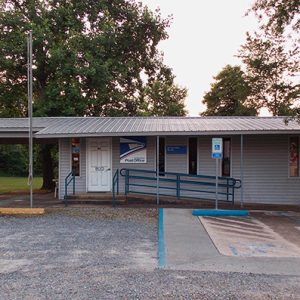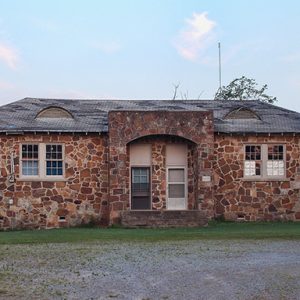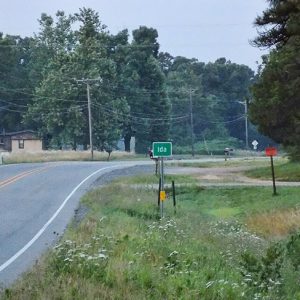calsfoundation@cals.org
Ida (Cleburne County)
Ida of Cleburne County is on Highway 25 (Heber Springs Road) about three miles south-southeast of Drasco (Cleburne County) and about four miles north-northeast of Tumbling Shoals (Cleburne County). Its proximity to Heber Springs (Cleburne County) and Greers Ferry Lake results in a great deal of tourism-related traffic for the unincorporated community.
The Osage once lived in the area, with part of their territory now under Greers Ferry Lake. The Old Cherokee Boundary Line goes by Ida, running diagonally from Wolf Bayou (Cleburne County) across the lake. The Treaty of the Cherokee Agency of 1817 created the definition for the line. General William Rector, along with commissioners appointed by the Cherokee, conducted the original survey. Because of concerns of white settlers living in the lands assigned to the Cherokee, a second treaty was negotiated in 1819. The surveys were completed after the Cherokee had given up their lands in Arkansas by 1828.
The area around Peter Creek was sparsely populated by a few hunters and trappers by 1818. A trading post was established at Crossroads (or Cross Roads), which is present-day Drasco, near the creek to cater to their needs. Peter Creek was close to the main roads leading from Batesville (Independence County) to Clinton (Van Buren County) and from Richwoods (Stone County) to Searcy (White County). Thus, during the Civil War when Union armies were marching through in their efforts to control Batesville, Searcy, and the surrounding areas, confrontations erupted in the hills around Peter Creek, the most significant being the Skirmish at Cross-Roads on March 27, 1864, where Drasco is located today. The Ozark hills were rife with bushwhackers, jayhawkers, and other irregulars by the end of the war—looting, pillaging, and creating mayhem.
An influx of farmers settled along Peter Creek beginning in the 1850s and increasing rapidly following the devastating Civil War. The main crops grown in the rocky hill soil were corn, cotton, wheat, and even a small amount of tobacco. A few farmers in the area found it more profitable to make moonshine from their grain crops, especially the corn, and illegal stills were built in the rocky hills around Ida.
Calvin Dill was born in the Peter Creek region in 1866; his family had moved to the area in about 1858. He married Mary Jane Edna Byrd from North Carolina in 1886 and, by the 1890s, was prominent in the Ida community, running a sawmill and cotton gin. He soon built a grist mill and operated it until his death in 1939. During the same period, James Mitchell Lacy opened his blacksmith shop in Ida, with his sons working with him. James Elison Foust had moved his family to the area from Mississippi in the early 1850s but, because of Union sympathies, moved to Missouri during the war years. On his return, he dammed the Big Creek tributary and built a grist mill. When water was low, Foust used a team of oxen as a power source for the grinding. Some in the area raised livestock. Many residents worked in some of the sawmills and stave mills that were established in the area.
One significant post–Civil War settler was Ansil Isaiah “Isah” Rowe. He was born in Fayette County, Ohio, and married Martha Jane Blackwood in Illinois in 1848. He brought his wife and the majority of their thirteen children to Arkansas in the 1870s to farm along Peter Creek. He is buried in Pleasant Ridge Cemetery in Ida. Ida’s post office, which is still active, was established on May 25, 1891, with Rowe appointed the first postmaster. Rowe submitted the name of his sister, Ida, as the name for the new post office. By the early 1900s, several country stores were located in the Ida area, operated by Noah Cannon as well as the Wards, Spinks, Powells, Fiches, and Nortons.
The first schools in Ida appeared in the late 1800s. One was called the Dill School but was later renamed Center Ridge, and the other was Pine Grove School. In the early 1900s, there was a school at Antioch (Cleburne County) and one in Ida. These schools were consolidated with the Wilburn (Cleburne County) and Concord (Cleburne County) schools in the 1920s and 1930s.
Churches played an important role in the development of Ida. Around 1899, John A. Knight organized the Pleasant Ridge log church where the Pleasant Ridge Cemetery is located; even the church’s pews were made of rough-hewn logs. The log church was replaced by a modern church building in 1918. A general Baptist church was organized at the Center Ridge School. The Pleasant Ridge Union Church was built during World War II.
Beginning in the 1940s and 1950s, the poultry industry expanded the economy. Today, many tourists, campers, and other travelers pass through Ida each day. In addition to the post office, Ida has several businesses.
For additional information:
Barger, Carl J. Cleburne County and Its People. 2 Vols. Bloomington, IN: AuthorHouse, 2008.
Berry, Evalena. Time and the River: A Centennial History of Cleburne County. Little Rock: Rose Publishing Company, 1982.
Fletcher, Erlee. “Ida and Drasco Communities.” Cleburne County Historical Journal 27 (Winter 2001): 122–124.
Kenneth Rorie
Van Buren, Arkansas
 Cleburne County Map
Cleburne County Map  Ida Post Office
Ida Post Office  Ida School
Ida School  Ida Street Scene
Ida Street Scene  Pine Grove School
Pine Grove School 




Comments
No comments on this entry yet.